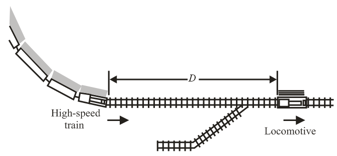A car moving at a constant velocity of passes a traffic cop who is readily sitting on his motorcycle. After a reaction time of the cop begins to chase the speeding car with a constant acceleration of . How much time does the cop need to overtake the speeding car?

Important Questions on Motion Along a Straight Line
You are driving towards a traffic signal when it turns yellow. Your speed is the legal speed limit of . Your best deceleration rate has the magnitude, . Your best reaction time to begin braking is . To avoid having the front of your car enter the intersection after the light turns red, should you brake to stop or continue to move at if the distance to the intersection and the duration of the yellow light are:
(a) and and
(b) and ?
Give an answer of the brake, continue, either (if either strategy works), or neither (if neither strategy works and the yellow duration is inappropriate).
(a) Assuming the acceleration to be constant, what is the acceleration of the jet if it stops in due to the arresting cable that snags it?
(b) If the jet first touches at position what is its final position along an -axis lying under its landing path?
You are arguing over a cell phone while trailing an unmarked police car by . Both your car and the police car are travelling at . Your argument diverts your attention from the police car for (long enough for you to look at the phone and yell, "I won't do that!"). At the beginning of that , the police officer begins braking suddenly at .
(a) What is the separation between the two cars when your attention finally returns? Suppose that you take another to realise your danger and begin braking.
(b) If you also brake at , what is your speed when you hit the police car?
When a high-speed passenger train travelling at rounds a bend, the engineer is shocked to see that a locomotive has improperly entered onto the track from a siding and is a distance ahead. When the locomotive is moving at , the engineer of the high-speed train immediately applies the brakes. (a) What must be the magnitude of the resulting constant deceleration if a collision is to be just avoided? (b) Assume that the engineer is at when at , he first spots the locomotive. Sketch curve for the locomotive and high-speed train for the cases in which a collision is just avoided and is not quite avoided.

(a) What is its initial speed as it leaves the ground?
(b) What is its speed at the height
(c) How much higher does it go?
A man releases a stone at the top edge of a tower. During the last second of its travel, the stone falls through a distance of where is the tower's height. Find .
(b) Would it be safe to walk outside during a rainstorm?
